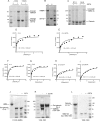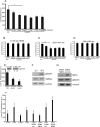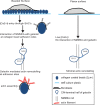Collagen remodeling by phagocytosis is determined by collagen substrate topology and calcium-dependent interactions of gelsolin with nonmuscle myosin IIA in cell adhesions
- PMID: 23325791
- PMCID: PMC3596245
- DOI: 10.1091/mbc.E12-10-0754
Collagen remodeling by phagocytosis is determined by collagen substrate topology and calcium-dependent interactions of gelsolin with nonmuscle myosin IIA in cell adhesions
Abstract
We examine how collagen substrate topography, free intracellular calcium ion concentration ([Ca(2+)]i, and the association of gelsolin with nonmuscle myosin IIA (NMMIIA) at collagen adhesions are regulated to enable collagen phagocytosis. Fibroblasts plated on planar, collagen-coated substrates show minimal increase of [Ca(2+)]i, minimal colocalization of gelsolin and NMMIIA in focal adhesions, and minimal intracellular collagen degradation. In fibroblasts plated on collagen-coated latex beads there are large increases of [Ca(2+)]i, time- and Ca(2+)-dependent enrichment of NMMIIA and gelsolin at collagen adhesions, and abundant intracellular collagen degradation. NMMIIA knockdown retards gelsolin recruitment to adhesions and blocks collagen phagocytosis. Gelsolin exhibits tight, Ca(2+)-dependent binding to full-length NMMIIA. Gelsolin domains G4-G6 selectively require Ca(2+) to interact with NMMIIA, which is restricted to residues 1339-1899 of NMMIIA. We conclude that cell adhesion to collagen presented on beads activates Ca(2+) entry and promotes the formation of phagosomes enriched with NMMIIA and gelsolin. The Ca(2+) -dependent interaction of gelsolin and NMMIIA in turn enables actin remodeling and enhances collagen degradation by phagocytosis.
Figures







Similar articles
-
Gelsolin and non-muscle myosin IIA interact to mediate calcium-regulated collagen phagocytosis.J Biol Chem. 2011 Sep 30;286(39):34184-98. doi: 10.1074/jbc.M111.247783. Epub 2011 Aug 2. J Biol Chem. 2011. PMID: 21828045 Free PMC article.
-
TRPV4 mediates the Ca2+ influx required for the interaction between flightless-1 and non-muscle myosin, and collagen remodeling.J Cell Sci. 2017 Jul 1;130(13):2196-2208. doi: 10.1242/jcs.201665. Epub 2017 May 19. J Cell Sci. 2017. PMID: 28526784
-
Flightless I interacts with NMMIIA to promote cell extension formation, which enables collagen remodeling.Mol Biol Cell. 2015 Jun 15;26(12):2279-97. doi: 10.1091/mbc.E14-11-1536. Epub 2015 Apr 15. Mol Biol Cell. 2015. PMID: 25877872 Free PMC article.
-
Mammalian nonmuscle myosin II comes in three flavors.Biochem Biophys Res Commun. 2018 Nov 25;506(2):394-402. doi: 10.1016/j.bbrc.2018.03.103. Epub 2018 Mar 17. Biochem Biophys Res Commun. 2018. PMID: 29550471 Free PMC article. Review.
-
Effects of cadmium on the actin cytoskeleton in renal mesangial cells.Can J Physiol Pharmacol. 2013 Jan;91(1):1-7. doi: 10.1139/cjpp-2012-0229. Epub 2013 Jan 1. Can J Physiol Pharmacol. 2013. PMID: 23368511 Review.
Cited by
-
From Structure to Phenotype: Impact of Collagen Alterations on Human Health.Int J Mol Sci. 2018 May 8;19(5):1407. doi: 10.3390/ijms19051407. Int J Mol Sci. 2018. PMID: 29738498 Free PMC article. Review.
-
Targeted Drug Delivery via the Use of ECM-Mimetic Materials.Front Bioeng Biotechnol. 2020 Feb 18;8:69. doi: 10.3389/fbioe.2020.00069. eCollection 2020. Front Bioeng Biotechnol. 2020. PMID: 32133350 Free PMC article. Review.
-
Engineering a collagen matrix for cell-instructive regenerative angiogenesis.J Biomed Mater Res B Appl Biomater. 2020 Aug;108(6):2407-2416. doi: 10.1002/jbm.b.34573. Epub 2020 Jan 26. J Biomed Mater Res B Appl Biomater. 2020. PMID: 31984665 Free PMC article. Review.
-
Endocytic recycling is central to circadian collagen fibrillogenesis and disrupted in fibrosis.Elife. 2025 Jan 15;13:RP95842. doi: 10.7554/eLife.95842. Elife. 2025. PMID: 39812558 Free PMC article.
-
Supervillin binding to myosin II and synergism with anillin are required for cytokinesis.Mol Biol Cell. 2013 Dec;24(23):3603-19. doi: 10.1091/mbc.E12-10-0714. Epub 2013 Oct 2. Mol Biol Cell. 2013. PMID: 24088567 Free PMC article.
References
-
- Arora PD, Bibby KJ, McCulloch CA. Slow oscillations of free intracellular calcium ion concentration in human fibroblasts responding to mechanical stretch. J Cell Physiol. 1994;161:187–200. - PubMed
-
- Arora PD, Fan L, Sodek J, Kapus A, McCulloch CA. Differential binding to dorsal and ventral cell surfaces of fibroblasts: effect on collagen phagocytosis. Exp Cell Res. 2003;286:366–380. - PubMed
Publication types
MeSH terms
Substances
Grants and funding
LinkOut - more resources
Full Text Sources
Other Literature Sources
Molecular Biology Databases
Research Materials
Miscellaneous

